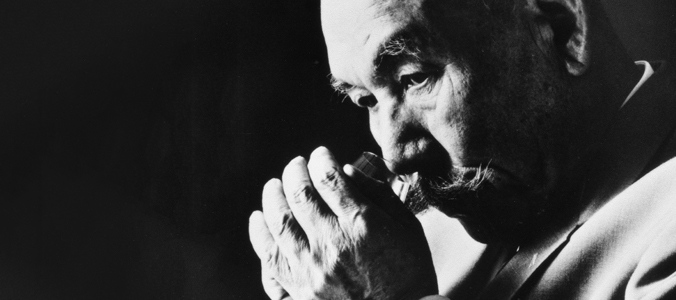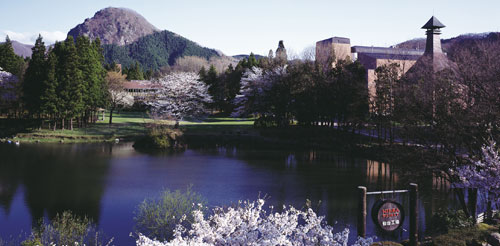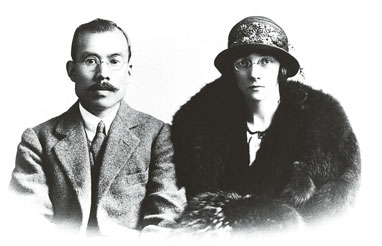Japanese whisky's Glasgow roots
In the last decade Japanese whisky has taken the world by storm, winning a clutch of awards and challenging Scotland’s position as the industry leader. Yet whisky in the Scottish tradition has been produced in Japan for almost a century and the story begins in Glasgow.

It was winter 1918 when a young Japanese man called Masataka Taketsuru arrived in Glasgow charged with learning the art of Scotland’s master distillers. This man would later become known as the father of Japanese whisky.
Replicating Western brewing and distilling techniques was becoming big business in Japan. In particular, manufacturers were attempting to replicate the iconic imported Scotch blends that were flooding the Japanese market. After experimenting with blends of different spices and herbs with limited success, Osaka-based Settsu Shuzo Company decided to send Masataka to the home of whisky to learn the secrets of this elusive art.
East meets West
Masataka enrolled at the University to study Organic Chemistry under Thomas Stewart Patterson, who held the Gardiner Chair of Chemistry. It was here that he learnt the fundamentals behind the distilling techniques in whisky manufacturing. He split his time between attending lectures and serving an apprenticeship at Hazelburn Distillery in Campbeltown, where he acquired first-hand experience of whisky production.
After a valuable year getting to grips with the fundamental chemistry and mechanics of malting, brewing and distilling, Masataka returned to Japan. He not only took the key to whisky production with him but also a new wife, Rita, a doctor’s daughter from Dunbartonshire whom he married in a hurried and secret ceremony at Calton Registry Office in January 1920.
Japan was in the grip of a post-war depression. World War I had derailed the Japanese economy and Settsu Shuzo was on the brink of bankruptcy. Drinks manufacturers and the consumer were more interested in cheap, cost-efficient liquors than investing in the more time-intensive and financially demanding practice of producing whiskies matured in the Scottish tradition.
The man behind the malt
 Masataka was still determined to pursue his dream of whisky making and eventually he was asked to oversee the building and management of the brand new Yamazaki Distillery near Osaka. Six years later he made history by overseeing the production of the first ever Japanese whisky, Suntory Shirofuda (White Label). However, the quality of the product proved unpopular among consumers, who were yet to be persuaded that whisky to rival Scotch could be produced in Japan, and sales were slow.
Masataka was still determined to pursue his dream of whisky making and eventually he was asked to oversee the building and management of the brand new Yamazaki Distillery near Osaka. Six years later he made history by overseeing the production of the first ever Japanese whisky, Suntory Shirofuda (White Label). However, the quality of the product proved unpopular among consumers, who were yet to be persuaded that whisky to rival Scotch could be produced in Japan, and sales were slow.
Over time it appeared that in order to pursue his single-minded quest for quality and authenticity Masataka would have to do it on his own terms. After leaving Suntory, he sought financial backing to build his own distillery.
A piece of Scotland
On the inhospitable and underdeveloped northern island of Hokkaido, Masataka found his own piece of Scotland in the small rural community of Yoichi. Not only did it have access to a ready supply of barley, coal and water, the cool coastal climate and peaty soils were ideal for growing barley and vital for replicating the aromas of the Scotch whiskies that Masataka had fallen in love with when in Glasgow.
In 1934 Masataka founded Nikka Whisky and began production, remaining true to the techniques employed by the traditional Scottish distilleries. Small onion-shaped stills were heated by a coal fire, giving the product a spicy flavour with more subtle smoky notes. Masataka even planted heather on the site to make it more authentic.
Until his death in 1979, Masataka continued to oversee whisky production at Nikka. The techniques that he popularised are still in evidence among the major Japanese whisky producers, who have gone on to win many medals at major whisky competitions around the world and whose products are mixing with the best in the world.
The legacy of Japanese whisky

Following his father
In 2002 Masataka’s son, Takeshi Taketsuru, visited Scotland to follow in the footsteps of his father. He was the special guest at a reception for an exhibition celebrating the University’s historic links with Japan.
Takeshi also founded a University prize to be awarded annually in memory of his father. The prize is awarded to the student showing the best performance in the work placement element of the Master of Science in Chemistry.
Building on the legacy
Over 80 years after Masataka Taketsuru studied at the University, Dr Koichi Inatomi has enrolled as a Research Fellow working on the history of distilling technology in the University Centre for Business History. Like Masataka, Dr Inatomi worked at the Yamazaki distillery, where he was a technologist for 25 years.
Looking at the implications that recent technical innovations have had for the whisky industry, Dr Inatomi is ensuring that his studies at the University will help to shape not only the past, but the future of Japanese whisky production.
Nikka Whisky
Masataka Taketsuru founded Nikka Whisky in 1934. The company has two malt whisky distilleries, one in Yoichi, Hokkaido (established in 1934), and the other in Aoba-ku, Sendai, Miyagi Prefecture, Northern Honshu (established in 1969). The company also owns the Ben Nevis Distillery (acquired in 1989) in Scotland. Photos in this feature are copyright Nikka Whisky.
Japanese connections
The first Japanese students registered at the University in the 1870s and were mainly graduates from the Imperial College of Engineering. Alumnus Kaichi Watanabe (BSc 1886) was one of the first Japanese engineers to study and work in the UK.
This article was first published in May 2013.

The secret of whisky production wasn’t the only prize that Masataka brought back from Scotland – he also returned to Japan with his wife, Rita Cowan. They married despite their families’ protests. By all accounts they had a very happy marriage, but for Rita the shock of adjusting to her new life proved hard. She had to learn a new language and an entire system of cultural norms.

